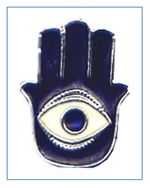Protection: Eyes can symbolize watchfulness and approval. They are used to ward off bad luck and protect from harm.
Evil Eye
 The evil eye is a concept found in many cultures and religions. This idea holds that a person possessing the evil eye can cause injury or even death to anyone they choose by simply gazing at them. Eye-shaped objects like these are used to protect people and property against the evil eye. Hamsa
The evil eye is a concept found in many cultures and religions. This idea holds that a person possessing the evil eye can cause injury or even death to anyone they choose by simply gazing at them. Eye-shaped objects like these are used to protect people and property against the evil eye. Hamsa

The symbol of an open hand, or hamsa, is found throughout the Middle East, North Africa, and Asia. It has been adopted by many of the world's religions and cultures as a general symbol of protection. When a stone or eye is added to the palm, it becomes a specific ward against the evil eye.